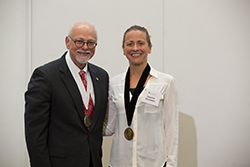Energy Award Supports Research on New Method of Making Ammonia

Ammonia production accounts for 3 percent of the world's carbon-dioxide emissions and consumes about 2 percent of the world's energy resources.
FAYETTEVILLE, Ark. – University of Arkansas engineering professor Lauren Greenlee and her colleagues at Case Western Reserve and Pennsylvania State universities have received a $599,373 award from the U.S. Department of Energy to study an alternative method for making ammonia.
Ammonia, a compound of nitrogen and hydrogen, is a colorless gas used as fertilizer in agricultural and food production. It is also used in many commercial cleaning products and as a building block for the synthesis of pharmaceutical products.
The standard method for producing commercial ammonia, the Haber-Bosch process, uses an iron-based catalyst and has not changed for about 100 years. It is a highly energy-intensive industrial process that accounts for 3 percent of the world’s carbon-dioxide emissions and consumes about 2 percent of the world’s energy resources. For these reasons, the Department of Energy and other agencies are seeking alternative technologies that demand less energy and are less harmful to the environment.
Chemists have tried to develop synthetic catalysts to replace the multi-stage Haber-Bosch process of combining nitrogen and hydrogen at high temperature and pressure. But they’ve run into problems with these alternative methods. Electrocatalysts – catalysts that function at electrode surfaces – struggle with the electrochemical reduction of water to hydrogen. Until the selectivity of the catalyst can be controlled, this technology will remain out of reach.
With help from colleagues Julie Renner at Case Western Reserve University and Mike Janik at Pennsylvania State University, Greenlee will focus on developing synthetic electrocatalysts that can reduce nitrogen gas to ammonia at temperatures below 100 degrees Celsius. They will try to develop a better understanding of how nitrogen and water interact with catalyst surfaces.
 |
| Lauren Greenlee with University of Arkansas Chancellor Joe Steinmetz. |
“Much is still unknown about this electrochemical reaction,” Greenlee said. “While the end goal of this work is to develop synthetic electrocatalysts for ammonia production, we will first take a huge step back and simply try to understand reactant transport to the catalyst surface.”
Greenlee holds the Louis Owen Professorship in Chemical Engineering.
About the University of Arkansas: The University of Arkansas provides an internationally competitive education for undergraduate and graduate students in more than 200 academic programs. The university contributes new knowledge, economic development, basic and applied research, and creative activity while also providing service to academic and professional disciplines. The Carnegie Foundation classifies the University of Arkansas among only 2 percent of universities in America that have the highest level of research activity. U.S. News & World Report ranks the University of Arkansas among its top American public research universities. Founded in 1871, the University of Arkansas comprises 10 colleges and schools and maintains a low student-to-faculty ratio that promotes personal attention and close mentoring.
Topics
Contacts
Lauren Greenlee, assistant professor, chemical engineering
College of Engineering
479-575-5976,
greenlee@uark.edu
Matt McGowan, science and research communications officer
University Relations
479-575-4246,
dmcgowa@uark.edu
Headlines
Four Students Named Goldwater Scholars; Two Earn Udall Honorable Mentions
Four U of A students have received the prestigious Goldwater Scholarship, an award for top students in mathematics, science, and engineering.
Cross-Campus Collaboration Culminates in New Outdoor Geological Installation
Grand opening event to celebrate the new GeoLab installation at the U of A’s Gearhart Hall courtyard is set for May 3. The installation will be open to the public year-round.
First Students to Use Online Degree to Hone Nursing Leadership, Elevate Patient Care
Hanna Baxendale and Wendi Kimbrell will begin coursework in the Doctor of Nursing Practice-Executive Master of Business Administration program offered by the Eleanor Mann School of Nursing and Walton College.
Join the Office for Sustainability on a Final Cruise to Campus
Cruise to Campus Wednesdays have fostered a gathering space for individuals interested in biking to campus. Drop by the Old Main Lawn from 7:30-10 a.m. Wednesday for coffee, something to eat and conversation.
Fay Jones School Student Ambassador Program Gives Voice to Design Students
The student ambassador program at the Fay Jones School of Architecture and Design is built to connect top design students with their school, its alumni, its future students and others inside and outside the school.




